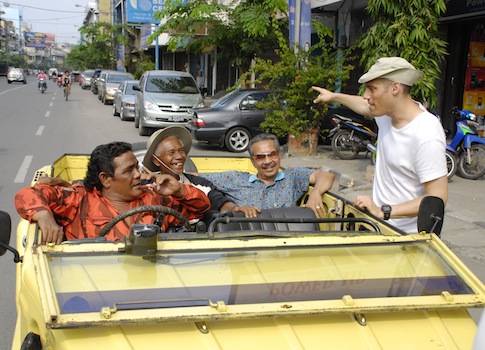The Act of Killing is an odd movie. The Oscar-nominated feature documentary is, in part, a look at mass murderers grown old, an examination of their feelings (or lack thereof) regarding the crimes they committed decades previously. It is also a surreal reconstruction of the crimes under consideration, played out by the killers themselves for director Joshua Oppenheimer. Finally, it’s a consideration of the way we choose to remember, and of the power of the moving image to shape the interpretation of history.
Oppenheimer’s subjects are a group of mass killers who led death squads during Suharto’s rise to power in Indonesia. Oppenheimer is not interested in merely talking to these killers. He asks them to join him in a film production of their crimes: They are given free rein to create in front of the camera what they did, and to explain what they were feeling when they did it.
As the documentary progresses, its subjects’ reactions to what they did change as well. Anwar Congo, at first preening for the camera—constantly fiddling with fake teeth, worrying about his hair color—tries to show he regrets the things he has done. He talks of nightmares and regrets; by the end of the film he is retching while walking around an area where many of the killings took place.
His compatriots show less concern. Herman Koto seems to think this is his big break. He takes to dressing up in drag (a film needs comedy, he tells Oppenheimer) and organizing elaborate dance routines in front of a giant fish. It’s absurd and garish and strangely compelling, like something out of a Terry Gilliam production. Adi Zulkadry, meanwhile, seems to realize midway through the film that he will be shown in a negative light, which could damage the public perception of Indonesia’s crackdown on communists.
Adi’s concerns—as well as those of a paramilitary leader we see later on, worrying that his troops look too bloodthirsty as they shoot a scene in which a village is burned, its people murdered, its women raped—strikes me as the most interesting component of the documentary. The way the subjects’ self-interest mingles with their desire to portray the events artistically and realistically leads us to consider the very nature of the documentary form. How honest can a mass murderer really be?
As a historical document, The Act of Killing is not terribly useful. There is little in the way of context about the Indonesian killings, and we don’t spend much time with the victims of the mass murders. That’s a shame, as the most powerful scene in the film is of a man telling the story of how the death squads took his stepfather away. You can see him struggling with his emotions. He repeatedly says he is not angry about the man’s murder, but you can see the rage welling up inside. Eventually tears roll down his face. He understands his powerlessness even now, more than 40 years after the fact.
Oppenheimer is less interested in this man’s pain than in allowing the likes of Congo to put on a showy display of, frankly, fraudulent-looking contrition. The Act of Killing is as much a movie about the movies as it is a movie about real-life horror.
